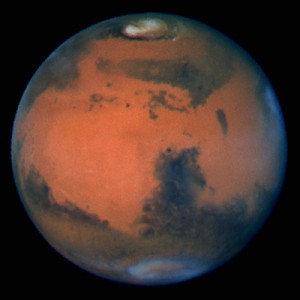The planet Mars

Source: NASA
Mars is the fourth planet in the solar system and is classified as a terrestrial planet. It is roughly half the size of Earth, has a lower average density, and consequently, only about 38% of Earth's gravity. Mars boasts a very thin CO2 atmosphere, with surface pressure measuring less than 1% of Earth's atmospheric pressure at sea level. Due to its greater distance from the sun, resulting in lower temperatures, and its thin atmosphere, liquid water is not present on the surface. The low atmospheric pressure causes water to transition directly from a frozen to a gaseous state. It is believed that the Martian atmosphere was much denser in earlier times, likely due to a greenhouse effect generated by high volcanic activity. Over time, the atmosphere thinned, and any existing lakes possibly froze. Due to the relatively low escape velocity (the speed needed to leave the gravitational field of a body) of approximately 5 km/s (compared to Earth's 11 km/s), much of the water and atmosphere has escaped to date. Currently, visible water exists only in the form of polar ice caps, which emerge beneath frozen CO2 ice caps during the local Martian summer. Additionally, frozen water can be found in deep craters.
Due to the low atmospheric density, temperatures on Mars undergo significant fluctuations.